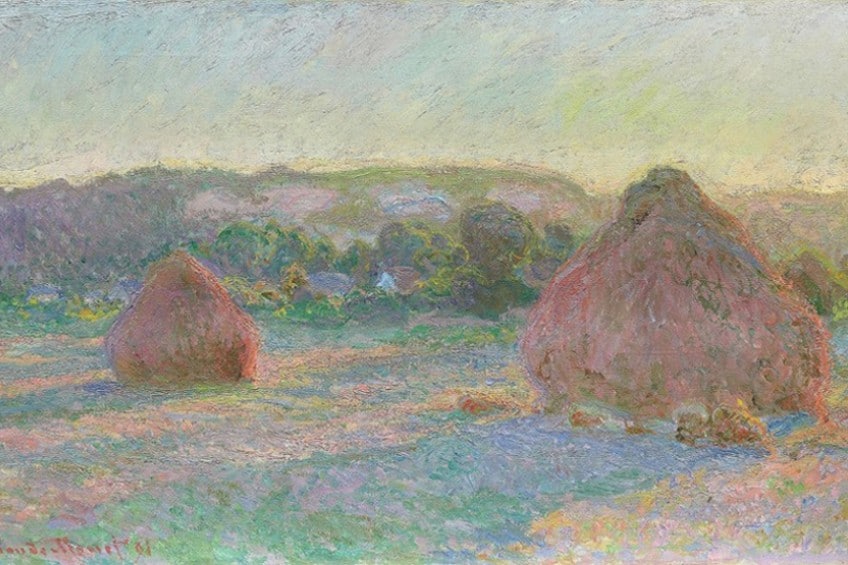“Haystacks” by Claude Monet – Explore Monet’s Wheatstacks
Haystacks by Claude Monet is a series of Impressionist paintings this artist created of the grainstacks at Giverny in Normandy, France. The paintings’ original French title is Meules, which is often also translated as Wheatstacks. In this article, we will do a visual analysis of the general composition of a Haystacks painting to understand what made it so influential in the Impressionism art movement. We will also contextualize the Wheatstacks painting series within Claude Monet’s career and the socio-political environment the artworks were created in.
Contents
Artist Abstract: Who Was Claude Monet?
Claude Monet was a French painter and one of the founders of the Impressionist movement. Born in Paris in 1840, Monet grew up in the Normandy region of France, where he developed a passion for drawing and painting at a young age. He received some artistic training at a local school, but he was largely self-taught and developed his own distinctive style.
Monet’s early works were influenced by the Barbizon School of landscape painting, and he became known for his paintings of the Normandy countryside.
In 1866, he exhibited his painting “The Woman in the Green Dress” at the Paris Salon, which attracted the attention of other artists and critics. This marked the beginning of Monet’s career as a professional painter, and he went on to exhibit his works regularly at the Salon.

In the 1870s, Monet began to experiment with new techniques and styles, and he became one of the leading figures in the Impressionist movement. His paintings, which captured the fleeting, ephemeral qualities of the natural world, were characterized by bold brushstrokes, vibrant colors, and a focus on light and atmosphere. Monet’s series of paintings featuring his wife Camille and their son Jean, known as the Woman with a Parasol series, are considered to be some of his most iconic and well-known works.
Monet’s influence on Impressionism was significant, and he continued to experiment and innovate throughout his career.
He is known for his series of paintings featuring haystacks, water lilies, and the Rouen Cathedral, which he completed over several years and in different weather conditions. Monet’s dedication to capturing the beauty and vibrancy of the natural world in his paintings had a profound impact on the development of Impressionism and continues to be celebrated by artists and art lovers today.
Haystacks by Claude Monet
| Date | 1890 – 1891 |
| Medium | Oil on canvas |
| Style | Impressionism |
| Series | Haystacks/Wheatstacks/Meules |
| Genre | Landscape painting |
| Theme | Wheatstacks |
| Dimensions (cm) | 60 x 100 |
| Location | Musée d’Orsay and Musée Marmottan Monet, Paris, France; Art Institute of Chicago, United States |
The Impressionist paintings of the Grainstacks at Giverny by Claude Monet are some of the most famous Impressionist paintings today. The series is a quintessential example of Monet’s experiments of capturing light and color on the same subject matter at different times of the day and seasons. In this section of the article, we will contextualize the Meules paintings within Monet’s career, his life in France when he created the works, and the influences that inspired the Haystacks painter to create this series of works.
Haystacks Contextualized With Monet’s Career
Impressionism was a style of painting that sought to capture the fleeting impressions of light and color that are experienced in the natural world. Monet and other Impressionist painters often worked outdoors, using quick brushstrokes and vibrant colors to capture the feeling of a particular moment in time. In the late 1880s, Monet began a series of paintings depicting haystacks in a field near his home in Giverny, France.
These paintings were not simply landscapes, but rather studies of light and color. Monet was interested in how the appearance of the haystacks changed throughout the day, depending on the angle of the sun and the quality of the light.
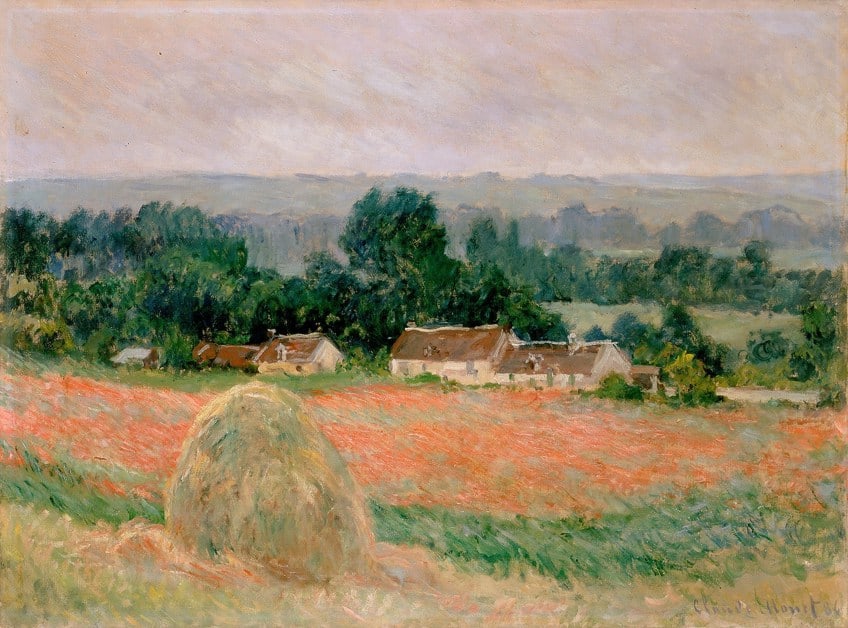
The Haystacks paintings were a critical success for Monet, and they helped to establish him as a leading figure in the Impressionist movement. They also marked a shift in Monet’s career, as he began to focus more on the study of light and color in his work. In addition to the Haystacks paintings, Monet is also known for his series of paintings depicting the water lilies in his garden at Giverny.
These paintings, which he worked on for much of his later career, are considered some of the greatest works of the Impressionist movement.
Socio-Political Context of Haystacks by Claude Monet
Haystacks by Claude Monet was created during a time of great social and political upheaval in France. The country was in the midst of the Industrial Revolution, which was transforming the way people lived and worked. At the same time, the French people were becoming increasingly aware of the inequalities and injustices that were present in society. The Impressionist movement, of which Monet was a leading figure, was a response to these changes.
Impressionist painters sought to capture the fleeting impressions of light and color that were experienced in the natural world, as a way of escaping from the increasingly industrialized and urbanized society.
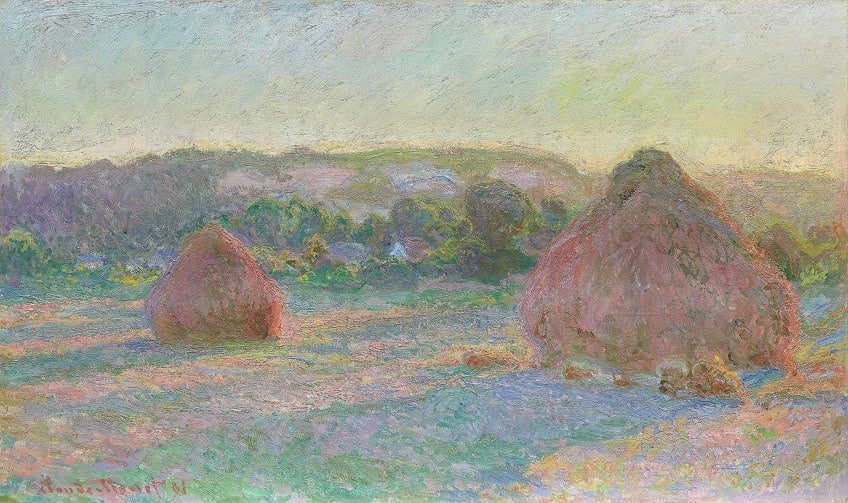
The Haystacks paintings were particularly significant in this context. Monet chose to depict simple, rural scenes, depicting the quiet beauty of the countryside. These paintings were a celebration of the natural world and a rejection of the industrialization and urbanization that was taking place in France.
By depicting these wheatstacks in such detail and with such care, Monet was also drawing attention to the value of this way of life, and the need to protect it.
Monet’s Influences
Monet’s famous Haystack paintings were influenced by several different artists, both from Monet’s own time and previous generations. One of the most significant influences on Monet’s Haystack paintings was the French artist Jean-Baptiste-Camille Corot (1796 – 1875), who is considered one of the pioneers of landscape painting in the 19th century. Corot’s landscape paintings were characterized by their soft, atmospheric qualities, which were achieved through his use of light and color. He often painted outdoors, directly from nature, and his work was a major influence on Monet and other Impressionist painters.
Monet’s Haystack paintings, like many of his other works, were directly inspired by Corot’s approach to landscape painting.
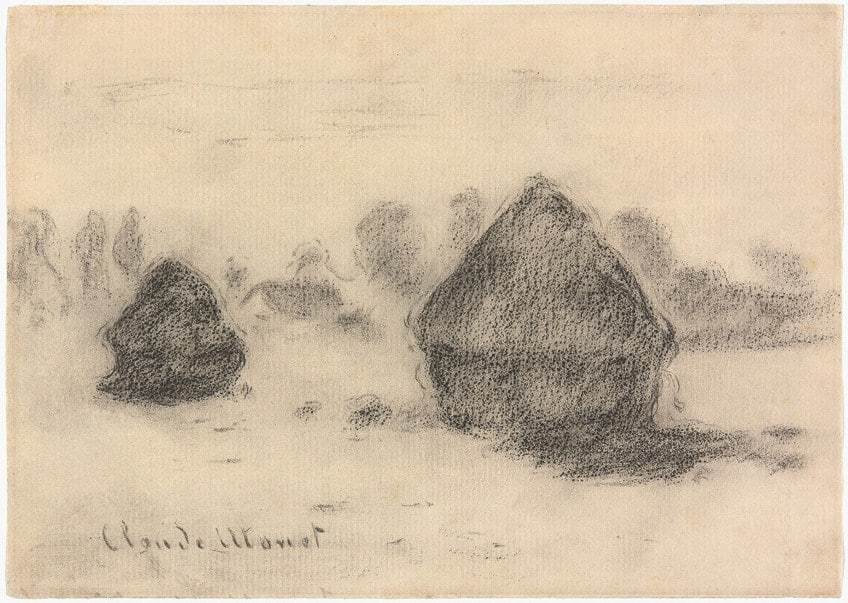
Another artist who influenced Monet’s Haystack paintings was John Constable (1776 – 1837), an English painter who is best known for his landscapes of the English countryside. Constable’s work was characterized by its attention to detail and its faithful depiction of nature.
Monet was impressed by Constable’s ability to capture the subtle changes in light and weather in his paintings, and he sought to emulate this quality in his own work.
In addition to these artists, Monet was also influenced by the Dutch painters of the 17th century, particularly Jan van Goyen (1596 – 1656) and Jacob van Ruisdael (1629 – 1882). These artists were known for their realistic depictions of landscapes, and Monet was drawn to their use of light and color to create mood and atmosphere in their paintings.
Comparative Visual Analysis of the Paintings in the Haystacks Series
Monet’s Haystacks paintings are some of the most famous works of the Impressionist movement. They are known for their bold colors and loose brushstrokes, which give the paintings a sense of movement and energy. The haystacks themselves are rendered in great detail, with Monet carefully capturing the way the light falls on their surface. In this section of the article, we will do a comparative visual analysis of some of the paintings included in this series of around 30 wheatstacks paintings.
Subject Matter and Compositional Overview
These paintings depict the grainstacks at Giverny near Monet’s home in France. The paintings are as much about the wheatstacks, as about the changing light and color on them as the sun changes throughout the seasons and at different times of the day.
The haystacks are also only at the service of Monet’s Impressionist study on how to render sunlight, and therefore the subject matter also includes the changing light.
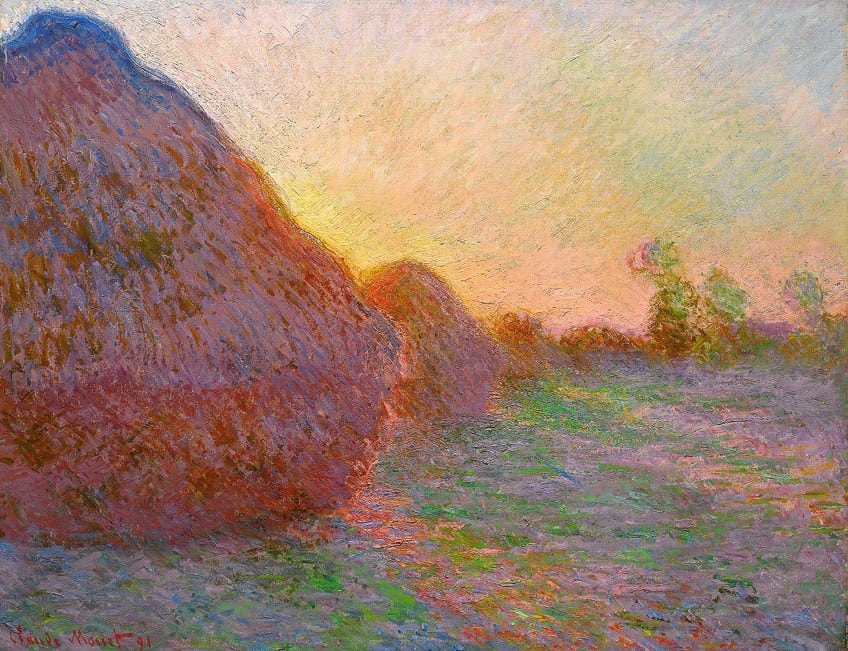
The composition of the paintings also varies, with some, like Haystacks at Dusk (1891), featuring a single haystack in the foreground and others, land like Haystacks in Sunlight (1891), showing a field of haystacks. Some of the paintings show a field in the background, whereas Haystacks (Effect of Snow and Sun) (1891) shows only two haystacks in a field covered in snow.
Light and Color
One of the most notable aspects of Monet’s haystack paintings is the way that they capture the changing light and color of the natural world. In many of these paintings, the haystacks themselves are rendered in great detail, with Monet carefully capturing the way the light falls on their surface.
The Haystacks at the End of the Day (1890)
| Date | 1890 |
| Medium | Oil on canvas |
| Style | Impressionism |
| Series | Haystacks/Wheatstacks/Meules |
| Genre | Landscape painting |
| Theme | Wheatstacks |
| Dimensions (cm) | 65.8 × 101 |
| Location | Mr. and Mrs. Lewis Larned Coburn Memorial Collection, housed at the Art Institute of Chicago, Chicago, United States |
One example of this is Monet’s painting The Haystacks at the End of the Day. In this painting, the haystacks are bathed in a warm, golden light, which gives the painting a sense of warmth and tranquility. The colors of the painting are also particularly striking, with Monet using bold, vibrant shades of orange, yellow, and red to capture the warmth of the setting sun.
The Haystacks in the Morning Sun (1891)
| Date | 1891 |
| Medium | Oil on canvas |
| Style | Impressionism |
| Series | Haystacks/Wheatstacks/Meules |
| Genre | Landscape painting |
| Theme | Wheatstacks |
| Dimensions (cm) | 65 x 100 |
| Location | Private collection |
Another example of Monet’s ability to capture the changing light and color of the natural world can be seen in his painting The Haystacks in the Morning Sun (1891). In this painting, the haystacks are bathed in a cool, pale light, which gives the painting a sense of calm and serenity.
The colors of the painting are also muted and subdued, with Monet using soft shades of blue and green to capture the coolness of the morning sun.
Brushwork
In addition to capturing the changing light and color of the natural world, Monet’s haystack paintings are also notable for their loose, Impressionistic brushwork. This can be seen in his painting The Haystacks at Dusk (1891). In this painting, Monet uses quick, bold brushstrokes to create a sense of movement and energy.
The colors of the painting are also particularly striking, with Monet using deep shades of purple and blue to capture the coolness of the evening sky.
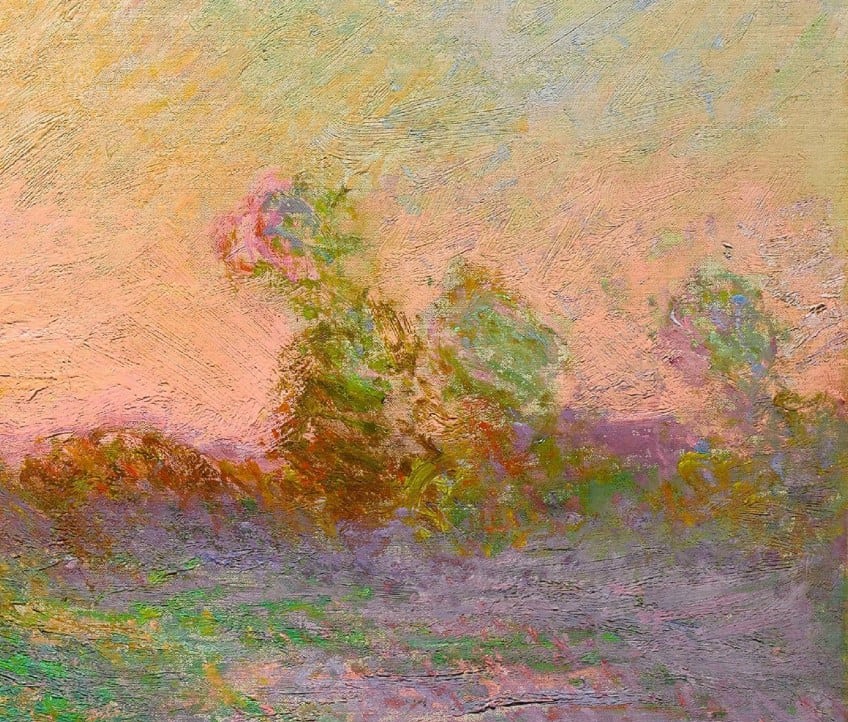
Perspective
Claude Monet’s Haystacks paintings are known for their unique perspectives. In Haystacks in Sunlight (1891), Monet portrays the haystacks from a low angle, looking up at the stacks and capturing the way the sunlight filters through the gaps between the stalks of hay. This perspective gives the painting a sense of majesty and grandeur as if the viewer is in awe of the towering haystacks.
In contrast, Haystacks at Dusk (1891) is painted from a higher angle, looking down at the haystacks and giving the painting a sense of intimacy and closeness.

This perspective allows the viewer to see the individual stalks of hay and the way they are arranged, creating a sense of texture and detail. Overall, Monet’s use of perspective in these paintings helps to convey the mood and atmosphere of the landscape, adding to their beauty and impact.
The Aftermath of the Impressionist Paintings of Wheatstacks
The Haystacks painter, Claude Monet, was such an influential painter because the broke many of the traditional painting rules when he created this series of works. In this last section of the article, we will look at what made the Haystacks paintings so revolutionary, how the public received the work when it was first exhibited, and how this series influenced the paintings Monet created after it.
What Made Haystacks by Claude Monet So Revolutionary?
Overall, Monet’s haystack paintings were revolutionary because they challenged traditional ideas about landscape painting, used bold colors and Impressionistic brushwork, and addressed the social and political issues of the time. These innovations helped to establish Monet as a leading figure in the Impressionist movement, and they continue to be celebrated by art lovers around the world.
Capturing Sunlight
Monet’s Haystacks paintings were revolutionary for several reasons. One of the most notable aspects of these paintings is the way that they capture the momentary images of light and color on a landscape. This was a departure from the traditional approach to landscape painting, which often sought to depict scenes in a highly detailed and realistic manner.
Because of this intention to focus on light, the subject matter of the paintings became less important and, therefore, Monet painted everyday scenes with little significance.
This was revolutionary at the time as artists were bound to depict specific things that were relevant to literature, history, politics, or religion. Monet as well as the whole project of Impressionism, therefore, added to freeing artists to paint what they want no matter how insignificant the subject matter.
Feathery Brushstrokes
Another factor that made Monet’s Haystacks paintings revolutionary was their use of bold, vibrant colors. Monet and other Impressionist painters were known for their use of bright, bold colors, which they applied to the canvas in loose, Impressionistic brushstrokes. This was in contrast to the more muted colors and carefully modeled forms that were used by many of the painters of the time.

Societal Commentary
In addition to these technical innovations, Monet’s Haystacks paintings were also significant for the way that they challenged traditional ideas about the role of art in society. The Impressionist movement, of which Monet was a leading figure, was a response to the changes that were taking place in French society during the Industrial Revolution.
Impressionist painters sought to capture the fleeting impressions of the natural world to escape from the increasingly industrialized and urbanized society.
Reception of Wheatstacks
In 1891, the first time Claude Monet’s series of paintings known as the Haystacks were exhibited to the public. The paintings, which depicted stacks of hay in various states of illumination, caused quite a stir in the art world at the time. Many critics and members of the public were puzzled by Monet’s decision to focus on such a seemingly mundane subject.

One famous art critic of the time, Roger Fry (1866 – 1934), wrote that the paintings were “too realistic” and accused Monet of lacking imagination. However, other well-known critics such as John Ruskin (1819 – 1900) and Gustave Geffroy (1855 – 1926) praised the artist for his ability to capture the subtle changes in light and color that occurred throughout the day.
The Impact Monet’s Haystacks Had on Art History
Monet’s Haystack paintings were a significant development in the history of art, and they had a profound influence on the art that followed. One of the most significant ways in which Monet’s Haystacks paintings influenced art was through their focus on the changing qualities of light and weather. Monet’s paintings were not static, idealized representations of the landscape, but rather dynamic and constantly changing scenes that captured the fleeting effects of light and weather.
This emphasis on the ephemeral and the fleeting was a major departure from traditional landscape painting, and it was a key aspect of the Impressionist style.
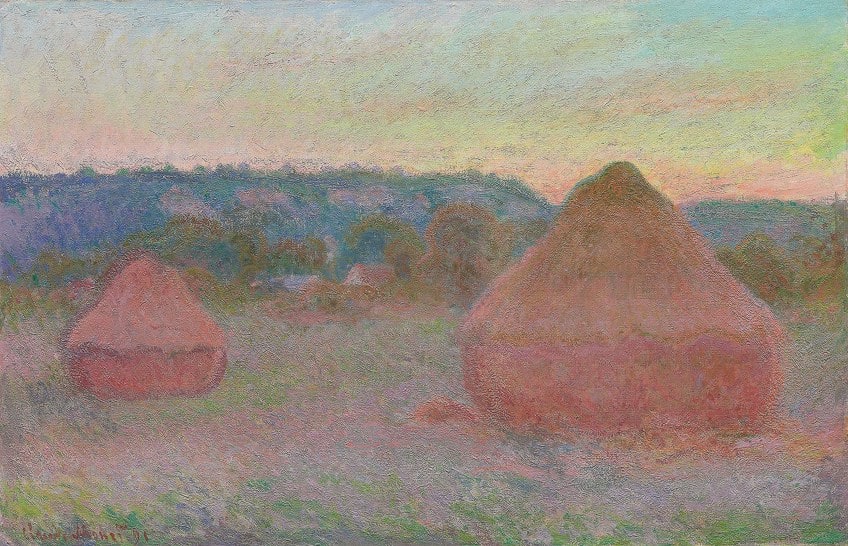
Monet’s Haystack paintings also had a profound influence on the way artists approached the act of painting itself. Before Monet, landscape paintings were typically created in the studio, with artists relying on sketches and studies to create their works. Monet, however, often painted outdoors, directly from nature, and his Haystack paintings were a direct response to the scenes he observed in the countryside.
This approach to painting, known as Plein air, was embraced by other Impressionist artists and remains a popular approach to landscape painting to this day.
Haystacks in Context of Monet’s Other Series Work
Claude Monet’s Haystacks series set the tone for other painting series to follow by the Haystacks painter. The Water Lilies series (1840 – 1926), and the Poplars series (1891) are all similarly characterized as the Haystacks series by Monet’s signature style and use of light and color. However, each series has its own unique features and differences.
In the Haystacks series, Monet used thick, bold brushstrokes to create texture and depth in the paintings, as seen in Haystacks in Fog (1891) and Haystacks at Dusk (1891).
This gives the paintings a sense of solidity and structure, emphasizing the physical presence of the haystacks. In contrast, the Water Lilies series is characterized by its use of softer, more delicate brushstrokes to capture the reflection of the water and the play of light on the surface of the pond, as seen in Water Lilies (1919) and Water Lilies and Japanese Bridge (1899). This gives the paintings a sense of fluidity and movement, capturing the ephemeral beauty of the water lilies.
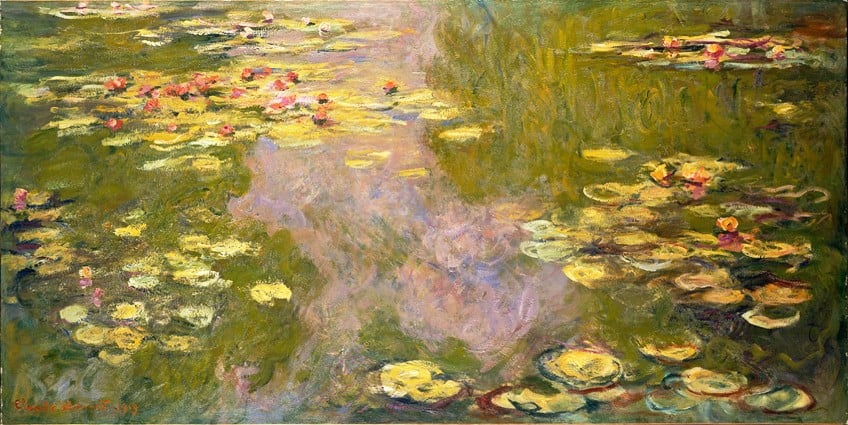
Finally, the Poplars series is distinguished by its use of a combination of both thick and thin brushstrokes to create a sense of movement and vitality in the paintings, as seen in Poplars on the Banks of the Epte (1891) and Poplars at Giverny (1896). This adds a sense of drama and energy to the paintings, capturing the movement of the trees as they sway in the wind.
The Haystacks series were created during a period of great artistic experimentation for Monet, and they helped to establish him as a leading figure in the Impressionist movement. Overall, Monet’s Haystacks paintings are a testament to his skill as an artist. Through his use of bold colors and loose brushwork, Monet was able to capture the fleeting impressions of light and color that are experienced in the natural world. These paintings are an important part of Monet’s career, and they continue to be celebrated by art lovers around the world.
Frequently Asked Questions
How Was Haystacks by Claude Monet Received by the Parisian Public?
Despite the mixed reception, the Haystacks series (1890 – 1891) went on to become some of Monet’s most iconic and well-known works. Today, they are considered an important part of the Impressionist movement and are admired for their technical prowess and the way they capture the essence of the French countryside.
How Many Haystacks Paintings Did Monet Create?
Monet created over 30 paintings of the grainstacks at Giverny or Meules (1890 – 1891). These Impressionist paintings were created in series because Monet was using the subject matter of wheatstacks to study the way light changes throughout the day and year.
Why Are the Haystacks Paintings Considered Revolutionary?
Haystacks (1890 – 1891) are part of the Impressionism art movement and changed the core of art history forever. These paintings allowed artists to just focus on the painterly nature of their work instead of sticking to traditional subject matters. Monet also set a different tone for artists to follow him by using bold colors, loose brush marks, and painting en Plein air.
Nicolene Burger, a South African multimedia artist and creative consultant, specializes in oil painting and performance art. She earned her BA in Visual Arts from Stellenbosch University in 2017. Nicolene’s artistic journey includes exhibitions in South Korea, participation in the 2019 ICA Live Art Workshop, and solo exhibitions. She is currently pursuing a practice-based master’s degree in theater and performance. Nicolene focuses on fostering sustainable creative practices and offers coaching sessions for fellow artists, emphasizing the profound communicative power of art for healing and connection. Nicolene writes blog posts on art history for artfilemagazine with a focus on famous artists and contemporary art.
Learn more about Nicolene Burger and about us.
Cite this Article
Nicolene, Burger, ““Haystacks” by Claude Monet – Explore Monet’s Wheatstacks.” artfilemagazine – Your Online Art Source. January 23, 2023. URL: https://artfilemagazine.com/haystacks-by-claude-monet/
Burger, N. (2023, 23 January). “Haystacks” by Claude Monet – Explore Monet’s Wheatstacks. artfilemagazine – Your Online Art Source. https://artfilemagazine.com/haystacks-by-claude-monet/
Burger, Nicolene. ““Haystacks” by Claude Monet – Explore Monet’s Wheatstacks.” artfilemagazine – Your Online Art Source, January 23, 2023. https://artfilemagazine.com/haystacks-by-claude-monet/.


